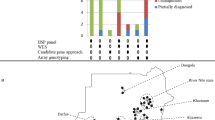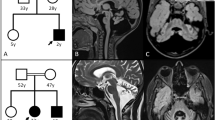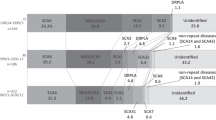Abstract
Autosomal dominant ataxias are a genetically heterogeneous group of disorders for which spinocerebellar ataxia (SCA) loci on chromosomes 6p, 12q, 14q and 16q have been reported. We have examined 170 individuals (56 of whom were affected) from a previously unreported ten-generation kindred with a dominant ataxia that is clinically and genetically distinct from those previously mapped. The family has two major branches which both descend from the paternal grandparents of President Abraham Lincoln. Among those examined, 56 individuals have a generally non-life threatening cerebellar ataxia. Disease onset varies from 10–68 years and anticipation is evident. We have mapped this gene, spinocerebellar ataxia type 5 (SCA5), to the centromeric region of chromosome 11
This is a preview of subscription content, access via your institution
Access options
Subscribe to this journal
Receive 12 print issues and online access
$209.00 per year
only $17.42 per issue
Buy this article
- Purchase on Springer Link
- Instant access to full article PDF
Prices may be subject to local taxes which are calculated during checkout
Similar content being viewed by others
References
Harding, A.E. The clinical features and classification of the late onset autosomal dominant cerebellar ataxia: a study of 11 families, including descendants of ‘The Drew Family of Walworth’. Brain 105, 1–28 (1982).
Zoghbi, H.Y. The spinocerebellar degenerations. Curr. Neurol. 11, 121–144 (1991).
Schut, J.W. Hereditary ataxia: Clinical study through six generations. Archs. Neurol. Psychiat. 63, 535–586 (1950).
Nino, H.E. et al. A family with hereditary ataxia: HLA typing. Neurology 3O, 12–20(1980).
Haines, J.L., Schut, L.J., Weitkamp, L.R., Thayer, M. & Anderson, V.E Spinocerebellar ataxia in a large kindred: age at onset, reproduction, and genetic linkage studies. Neurology 34, 1542–1548 (1984).
Zoghbi, H.Y. et al. Spinocerebellar ataxia: variable age of onset and linkage to human leukocyte antigen in a large kindred. Ann. Neurol. 23, 580–584 (1988).
Orozco Diaz, G., Nodarse Fleites, A., Cordoves Sagaz, R. & Auburger, G. Autosomal dominant cerebellar ataxia: clinical analysis of 263 patients from a homogeneous population in Holguin, Cuba. Neurology 40, 1369–1375 (1990).
Barbeau, A. et al. The natural history of Machado-Joseph disease An analysis of 138 personally examined cases. Can. J. neurol. Sci. 11, 510–525 (1984).
Rosenberg, R.N. Machado-Joseph disease: an autosomal dominant system degeneration. Mov. Dis. 7, 193–203 (1992).
Jackson, J.F., Currier, R.D., Terasaki, P.I. & Morton, N.E. Spinocerebellar ataxia and HLA linkage-risk prediction by HLA typing. New Engl. J. Med. 296, 1138–1141 (1977).
Ranum, L.P.W. et al. Localization of the autosomal dominant HLA-linked spinocerebellar ataxia (SCA1) locus, in two kindreds within an 8-cM subregion of chromosome 6p. Am. J. hum. Genet. 49, 31–41 (1991).
Zoghbi, H.Y. et al. The gene for autosomal dominant spinocerebellar ataxia (SCA1) maps telomeric to the HLA complex and is closely linked to the D6S89 locus in three large kindreds. Am. J. hum. Genet. 49, 23–30(1991).
Kwiatkowski, T.J. Jr., et al. The gene for autosomal dominant spinocerebellar ataxia (SCA1) maps centromeric to D6S89 and shows no recombination, in nine large kindreds, with a dinucleotide repeat at the AM10 locus. Am. J. hum. Genet. 53, 391–400 (1993).
Gispert, S. et al. Chromosomal assignment of the second locus for autosomal dominant cerebellar ataxia (SCA2) to chromosome 12q23–24.1. Nature Genet. 4, 295–299(1993).
Takiyama, Y. et al. The gene for Machado-Joseph disease maps to human chromosome 14q. Nature Genet. 4, 300–304 (1993).
Stevanin, G. et al. A third locus for autosomal dominant cerebellar ataxia type 1 maps to chromosome 14q24.3–qter: evidence for the existence of a fourth locus. Am. J. hum. Genet. 54 11–20 (1994).
Gardner, K. et al. Autosomal dominant spinocerebellar ataxia: clinical description of a distinct hereditary ataxia and genetic localization to chromosome 16 (SCA4) in a Utah kindred. Neurology 44, A361 (1994).
Orr, H.T. et al. Expansion of an unstable trinucleotide CAG repeat in spinocerebellar ataxia type 1. Nature Genet. 4, 211–226 (1993).
Ranum, L. et al. Molecular and clinical correlations in spinocerebellar ataxia type I (SCA1): evidence for familial effects on the age at onset. Am. J. hum. Genet. 55, 244–252 (1994).
Jodice, C. et al. Effect of trinucleotide repeat length and parental sex onphenotypic variation in spinocerebellar ataxia. Arn. J. hum. Genet. 54, 959–965(1994).
Kremer, E.J. et al. Mapping of DNA instability at the fragile X to a trinucleotide repeat sequence p(CCG)n . Science 252, 1711–1714 (1991).
Verkerk, A.J.M.H. et al. Identification of a gene (FMR-1) containing a CGG repeat coincident with a breakpoint cluster region exhibiting length variation in fragile X syndrome. Cell. 65, 905–914 (1991).
Fu, Y.-H. et al. An unstable triplet repeat in a gene related to myotonic muscular dystrophy. Cell 67, 1047–1058 (1991).
Knight, S. et al. Trinucleotide repeat amplification and hypermethylation of a CpG island in FRAXE mental retardation. Cell 74, 127–134 (1993).
La Spada, A.R., Wilson, E.M., Lubahn, D.B., Hardin, A.E. & Fischback, K.H. Androgen receptor gene mutations in X-linked spinal and bulbar muscular atrophy. Nature 352, 77–79 (1991).
Fu, Y.-H. et al. Variation of the CGG repeat at the fragile X site results in genetic instability: resolution of the Sherman paradox. Cell 67, 1047–1058 (1992).
Harley, H.G. et al. Expansion of an unstable DNA region and phenotypic variation in myotonic dystrophy. Nature 355, 545–546 (1992).
Mahadevan, M. et al. Myotonic dystrophy mutation: an unstable CTG repeat in the 3′ untranslated region of the gene. Science 255, 1253–1255 (1992).
Huntington's disease collaborative research group. A novel gene containing a trinucleotide repeat that is expanded and unstable on Huntington's disease chromosomes. Cell 72, 971–983 (1993).
Koide, R. et al. Unstable expansion of CAG repeat in hereditary dentatorubral-pallidoluysian atrophy (DRPLA). Nature Genet. 6, 9–13 (1994).
Nagafuchi, S. et al. Dentatorubral and pallidoluysian atrophy expansion of an unstable CAG trinucleotide on chromosome 12p. Nature Genet. 6, 14–18(1994).
Burke, J. et al. The Haw-River Syndrome: Dentatorubropallidoluysian atrophy (DRPLA) in an African-American family. Nature Genet. 7, 521–524 (1994).
Hoffman, P.M., Stuart, W.H., Earle, K.M. & Brody, J.A. Hereditary late-onset cerebellar degeneration. Neurology 21, 771–777 (1971).
Frontali, M. et al. Autosomal dominant pure cerebellar ataxia: neurological and genetic study. Brain 115, 1647–1654 (1992).
Buetow, K.H. et al. Integrated human genome-wide maps constructed using the CEPH reference panel. Nature Genet. 6, 391–396 (1994).
Terwilliger, J. & Ott, J. Handbook of human genetic linkage (Johns Hopkins University Press, Baltimore, 1994).
Keats, B.J.B. et al. Guidelines for human linkage maps: an international system for human linkage maps (ISLM 1990). Genomics 9, 557–560 (1991).
Chung, M.-Y., Ranum, L.P.W., Duvick, L.A., Servadio, A., Zoghbi, H.Y. & Orr, H.T. Evidence for a mechanism predisposing to intergenerational CAG repeat instability in spinocerebellar ataxia type 1. Nature Genet. 5, 254–258 (1993).
Bell, G.I., Kavam, J. & Putter, W. Polymorphic DNA region adjacent to the 5′ end of the human insulin gene. Proc. natn. Acad. Sci U.S.A. 78, 5759–5763 (1981).
Weber, J.L. et al. Evidence for human meiotic recombination interference obtained through construction of a short tandem repeat-polymorphism linkage map of chromosome 19. Am. J. hum. Genet. 53, 1079–1095 (1993).
Gyapay, G. et al. The 1993–94 Genethon human genetic linkage map. Nature Genet. 7, 246–339 (1994).
Lathrop, G.M., Lalouel, J.M., Julier, C. & Ott, J. Strategies for multilocus linkage analysis in humans. Proc. natn. Acad. Sci. U.S.A. 81, 3443–3446 (1984).
Author information
Authors and Affiliations
Rights and permissions
About this article
Cite this article
Ranum, L., Schut, L., Lundgren, J. et al. Spinocerebellar ataxia type 5 in a family descended from the grandparents of President Lincoln maps to chromosome 11. Nat Genet 8, 280–284 (1994). https://doi.org/10.1038/ng1194-280
Received:
Accepted:
Issue Date:
DOI: https://doi.org/10.1038/ng1194-280
This article is cited by
-
Spinocerebellar ataxias (SCAs) caused by common mutations
neurogenetics (2021)
-
Two novel missense variants in SPTBN2 likely associated with spinocerebellar ataxia type 5
Neurological Sciences (2021)
-
Eye movement changes in autosomal dominant spinocerebellar ataxias
Neurological Sciences (2020)
-
Essential Tremor Within the Broader Context of Other Forms of Cerebellar Degeneration
The Cerebellum (2020)
-
Spinocerebellar ataxia: an update
Journal of Neurology (2019)



